skip to main |
skip to sidebar
On Monday, 8th September 2014 I attended a business meeting in London. I decided to catch the 06:27 Virgin service from Wolverhampton, due into Euston at 08:15, which would give me a couple of hours spare before going to my meeting. This allowed me to have a look at the Liverpool Street terminus of the former Great Eastern Railway. I'd rarely visited Liverpool Street so I wanted to take a few pictures. My train reached Euston on time and I decided to walk to Euston Square underground station and take the Metropolitan Line (also carrying the Circle Line and Hammersmith & City Line trains at this point) five stops east to Liverpool Street.
By London Underground
The familiar old 'Met Line' 'A' stock has been replaced by the new Bombardier 'S' stock, described in a Wikipedia article here. When deliveries are complete, 191 trains will have been supplied for the Metropolitan, Circle, Hammersmith & City and District Lines, provided with air conditioning and capable of running from 750 volts d.c. when the power supply is upgraded. The introduction of this fleet has not been without a fair amount of grief. The picture below is actually the first 'S' stock train I saw, back in April 2011.

Bombardier 'S' stock.
Perhaps even now all the problems have not been eliminated: my 'S' stock train started away from Euston Square and, after a few yards, made a sudden stop. After a short pause, we set off again and there were no further oddities, although I did find the Mitsubishi air conditioning noisy.
Liverpool Street Station
On arrival at Liverpool Street, I made my way via the escalators to the concourse of the main-line station. This is light and airy beneath a complex glazed roof supported on cast iron columns. The mezzanine floor with its range of retail units in a curious modern style was less appealing.
 The concourse at Liverpool Street station.
The concourse at Liverpool Street station.
There have been so many rebuildings of the station that the present result is something of a pastiche, with many of the original features moved or modified. For example, the large War Memorial for World War I has been relocated and the lower left panel now features a set of lift doors.
 WWI War Memorial, complete with lift doors.
WWI War Memorial, complete with lift doors.
Liverpool Street Background
The station was first opened in 1874 to replace the earlier Bishopgate station (which became a goods depot). In 1890, work started to add a further 8 platforms on the eastern side of the station. The station suffered serious bomb damage during World War I but by the 1920s, an intensive suburban steam service (commonly called 'The Jazz') was carrying unprecedented numbers of commuters. In the 1930s, the electrification of the line to Shenfield was planned but implementation was delayed by World War II (when the station suffered bomb damage again). In 1949 the Shenfield line was electrified and, by 1960, the line to Chingford had also been electrified. The Broadgate Development, authorised in 1985, brought further major change. Broad Street Station (immediately to the west of Liverpool Street Station) was abolished and the area used for the development of commercial property. New connections allowed trains which had previously served Broad Street Station to be diverted to Liverpool Street Station. Further commercial building was authorised on the east side of Liverpool Street Station. A reconstruction of the station took place and, as part of the resignalling, Liverpool Street received the first Integrated Electronic Control Centre (IECC) in Britain. Queen Elizabeth II officially opened the redeveloped station in 1991. In 1993, the notorious Bishopgate Bombing caused further damage to the station. For more information on Liverpool Street, see the Wikipedia article here.
 Click here for larger image
Click here for larger image
Lines around Liverpool Street in 1906.
 Click here for larger image
Click here for larger image
Lines around Stratford in 1914.
Keith Jaggers has an interesting 1993 article about Liverpool Street here.
Travelling from Liverpool Street
In 2011 I'd travelled from Liverpool Street to Chelmsford for 'Lionsmeet 2011', described here.
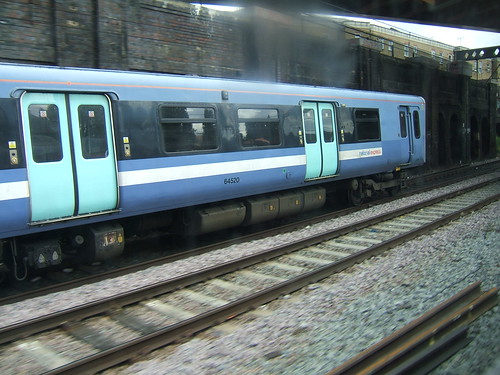 A 'national express' Class 313 service leaving Liverpool Street on the Down Suburban in 2011.
A 'national express' Class 313 service leaving Liverpool Street on the Down Suburban in 2011.
This time, I'd decided to travel as far as Stratford, so I made my way to a Southend service, a 12-car Class 321 in 'abellio greater anglia' livery. It appears that all these Train Operating Companies have a phobia concerning capital letters.
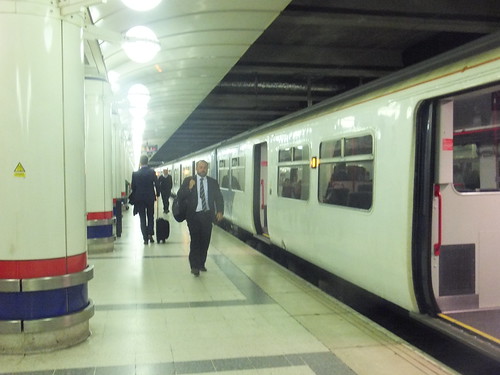 The Class 321 for Southend stands in Liverpool Street.
The Class 321 for Southend stands in Liverpool Street.
Leaving Liverpool Street, there are six running roads. From the west, the Down Suburban and Up Suburban pass through Bishopgate Tunnel, the Down Main and Up Main pass through a cutting, as do the Down Electric and Up Electric (despite the name, all six lines now have overhead electrification). Then we made the 1 in 70 climb to Bethnal Green, just over a mile from the start, where only the Suburban Lines have platforms before they sweep away to the left towards Hackney Downs, accompanied by two lines branched from the Main lines. Another mile and a half takes us to Bow Junction where a single line connection from the Fenchurch Street Lines joins on our right, together with the single line Docklands Light Railway from Poplar. On our left, the Down and Up Temple Mills diverge from the Main and run parallel while beyond lies the Olympic Park.
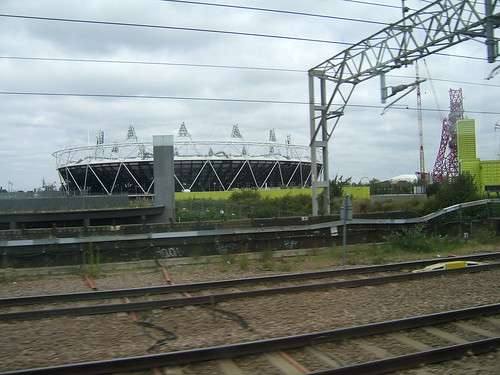 The Olympic Park under construction in 2011. L: Olympic Stadium R: ArcelorMittal Tower.
The Olympic Park under construction in 2011. L: Olympic Stadium R: ArcelorMittal Tower.
The budget for the Olympic Stadium in the original bid was 300 million pounds. It actually cost 429 million pounds. It's currently being converted as a new home for West Ham Football Club. This was supposed to cost 154 million pounds but, at the time of writing, there's a wrangle over problems with the roof estimated at 15 million pounds. The ArcelorMittal Orbit (as it's now called with its strange capitalisation within a word) was commissioned as a piece of "Public Art". Huh? The picture below shows the same location in 2014.
 The same location in 2014. L: West Ham stadium under conversion R: ArcelorMittal Orbit.
The same location in 2014. L: West Ham stadium under conversion R: ArcelorMittal Orbit.
Just before Stratford station, Carpenters Road Curve and Channelsea Curve form a triangular junction on our left. I alighted at Stratford and took a few pictures around the station. To the south east, the Central Line trains still pop out of the ground, pause briefly, then dive underground again. A single bay platform terminates the Docklands Light Railway branch from Poplar. To the north west, the Down and Up Temple Mills diverge to the left and, beyond, a fairly modern island platform terminates the Overground services. Beyond that, the Westfield Stratford City looms over everything. It's a big shopping centre with 336 'stores'. Whatever happened to 'shops'?
 View of Stratford Station from platform 9. L to R: Westfield Stratford City, Overground platforms, Down & Up Temple Mills platforms, Southend lines.
View of Stratford Station from platform 9. L to R: Westfield Stratford City, Overground platforms, Down & Up Temple Mills platforms, Southend lines.
I left the station and walked north along Montfichet Road, skirting the towering walls of the Westfield Stratford City to reach the bridge over the High Speed One extension into St. Pancras.
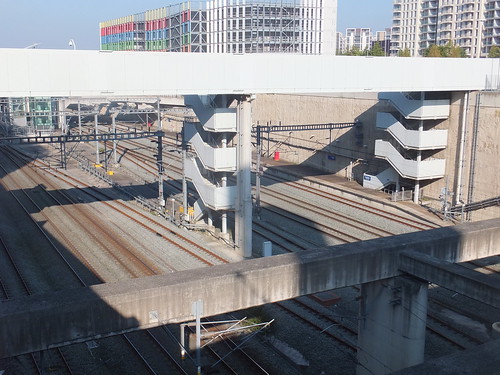 Trackwork at the east end of Stratford International.
Trackwork at the east end of Stratford International.
I returned to Stratford Station and decided that my best route to Victoria for my meeting would be Central Line to Oxford Circus and then Victoria Line two stops to Victoria. So that's what I did.
Books
[1] 'The Great Eastern Railway' by C. J. Allen published by Ian Allen (ISBN: 07110 0659 8).
[2] 'Great Eastern Album' by R. C. Riley published by Ian Allen (ISBN: 7110 0063 8).
[3] 'London's Termini' by A. A. Jackson published by Pan Books Ltd (ISBN: 0 330 02747 6).
Maps
'Railway Track Diagrams Book 2: Eastern' published by TRACKmaps (ISBN 0-9549866-2-8).
My pictures
London: Former Great Eastern Line.
Channel Tunnel and High Speed One.
London.
The Bradford Model Engineering Society was constituted in 1908 and claims to be the fourth oldest model engineering society in the world! Their website is here. On Saturday, 23rd August 2014, the Society hosted the 2014 'Lionsmeet' at their picturesque site in Northcliffe Woods, Shipley. 'Lionsmeet' is the annual get-together of live steam models of the 'Lion' locomotive organised by the Old Locomotive Committee (usually referred to as 'OLCO'). The OLCO website is here. Having been associated with OLCO myself for more than 25 years, my own blog has quite a few posts. You can find all my posts about 'Lion' - both the full-size version and live-steam models here.
Until 2013 (when 'Lionsmeet was held at the Wirral Model Engineering Society track at Royden Park) 'Lionsmeet' had always included a not-too-serious competition to see which model could produce the greatest 'work done' in ten minutes. As an experiment, the competition was omitted in 2013 and, following a fairly favourable response, the competition was also omitted from the 2014 event.
I travelled by train to Shipley (as described in the post Day Trip to Shipley) and then walked to Northcliffe Woods where a plaque on the main gate records their opening on 12th June 1920, the gift of Sir H Norman Rae MP, as an open space for recreation and benefit of the public, forever. The Friends of Northcliffe are a local community group involved in managing the area.
A pleasant walk through the woods led me to my destination. Uniquely, the Clubhouse is a converted Bandstand! The flat area in front of the building, originally for the audience, now boasts a raised oval track around 440 feet long with dual-gauge 3½" and 5". This track was relocated by the society from its previous home and, unusually, the dual-gauge track is 4-rail rather than the more common 3-rail.
 The Clubhouse. Far left, John Mills steps over the raised track.
The Clubhouse. Far left, John Mills steps over the raised track.
I was not surprised that David Neish was the first driver out onto the track, with his extremely reliable 'Lion'. Later, his son Andrew (who had organised the event) took over the engine.
 Lionsmeet 2014: David Neish with his 'Lion'.
Lionsmeet 2014: David Neish with his 'Lion'.
A turntable is positioned in the raised track, giving access to three steaming bays. The picture below shows the turntable, the passenger loading and unloading area beyond (used when giving public rides) and the short tunnel. In the foreground, the four aluminium rail construction of the dual-gauge track can be seen.
 The turntable on the raised track.
The turntable on the raised track.
Later a number of drivers, including Jon Swindlehurst, David Wainwright and a local 'Lion' sporting a very nice 'Lowmac' well wagon as a driving trailer put their 'Lion' models through their paces.
 John Mills and Jon Swindlehurst
John Mills and Jon Swindlehurst
 David Wainwright prepares his 'Lion'.
David Wainwright prepares his 'Lion'.
Alan Bibby was particularly unfortunate - he waited until his grandsons arrived so that they could assist in preparation and receive some driving tuition but, by this time, it had started to rain quite heavily. To add insult to injury, having given the crew a good soaking, the rain stopped and the sun came out again. Only a few weeks previously I'd experienced something similar when driving at the Battlefield Line on the 19th July (described in the post Another Busy Week). Once again, I was reminded of my saying: "Anyone can work on the footplate in good weather. It takes an engineman to do it in bad weather".
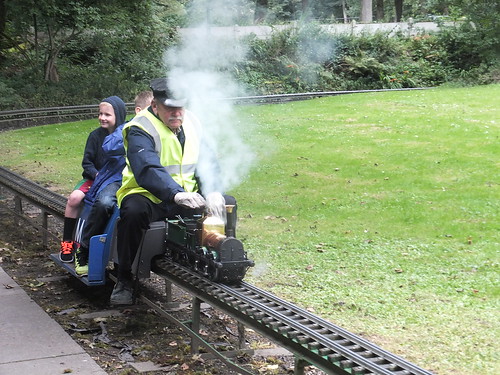 Alan Bibby, before the worst of the rain.
Alan Bibby, before the worst of the rain.
The host Club made us very welcome throughout the day with beverages, a morning bacon bap and, later, lunch. With the drivers mentioned above, the Chairman of OLCO, John Brandrick, Magazine Editor John Hawley and OLCO member Keith Taylor-Nobbs present, there was plenty of earnest discussion. Jon Swindlehurst's 7.25-in 0-4-2 locomotive under construction was much admired but some were perplexed by his decision to fit Stephenson Link Motion!
An early live-steam model of 'Lion' stirred considerable interest - the maker's plate is marked 'Worthing Works 1953'. The owner hopes that it will be in steam again next year.
 An early live-steam model of 'Lion'.
An early live-steam model of 'Lion'.
The Chairman of OLCO, John Brandrick decided that Keith Taylor-Nobbs should be the first recipient of the Charles Taylor-Nobbs Memorial Trophy, for his splendid 'Lion' model which was on display.
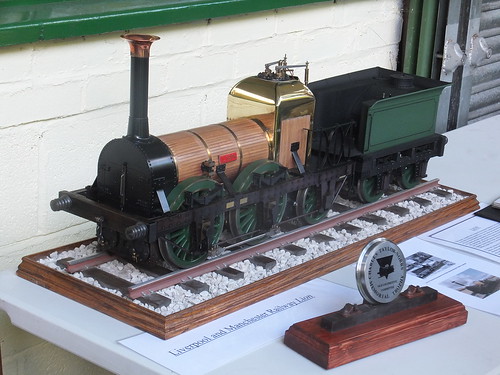 Keith Taylor-Nobbs museum-quality 'Lion' model was, appropriately, the first recipient of the Charles Taylor-Nobbs Memorial Trophy.
Keith Taylor-Nobbs museum-quality 'Lion' model was, appropriately, the first recipient of the Charles Taylor-Nobbs Memorial Trophy.
More recent developments at Bradford Model Engineering Society have centred on the construction of a ground level dual-gauge 5" and 7.25" track with a circuit of around 2,000 feet with a station area, turntable with steaming bays, carriage 'shed' (actually large concrete pipes) and a siding leading to the Store Room at the rear of the Clubhouse. The layout features dual-gauge points and diamond crossings.
 Dual-gauge Diamond Crossings on the ground level track.
Dual-gauge Diamond Crossings on the ground level track.
Seeing my interest, I was offered a ride around the track behind the Club's Petrol-Hydraulic locomotive (using a Honda engine). When we arrived at the station, which has three lines passing through it, I was shown the very professional signalling control panel. A small compressor is mounted below the control panel, providing air for the pneumatic operation of the main points. Very rugged colour light signals are provided where required.
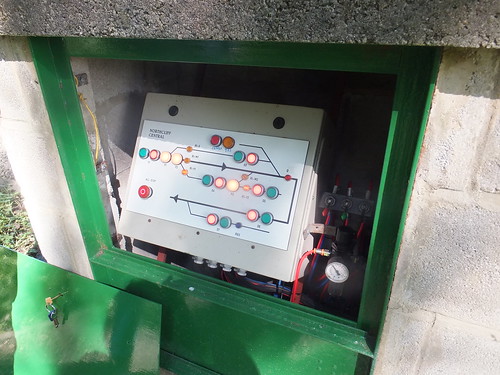 Control panel for points/signals at the station on the ground level track.
Control panel for points/signals at the station on the ground level track.
Before people started to leave, John Brandrick gave a vote of thanks to Bradford Model Engineering Society for their hospitality - it had been a good event.
 This rather nice Austin motor car was parked adjacent to the raised track for most of the day.
This rather nice Austin motor car was parked adjacent to the raised track for most of the day.
My pictures
Lionsmeet 2014.
On Saturday, 23rd August 2014 I made a day trip by train from Wolverhampton to Shipley (near Leeds in Yorkshire) to attend the 2014 'Lionsmeet' event organised by the Old Locomotive Committee (where I currently serve as Secretary). There's a report on 'Lionsmeet 2014' here.
In the past, I've sometimes travelled to Leeds via Birmingham and Derby but I'd decided to travel via Manchester to Leeds, allowing me to stop off at Huddersfield for photographs. In fact, the National Rail Journey Planner recommended the route via Manchester in any case.
The Outward Journey
I started from Wolverhampton at 06:49, catching the Arriva Cross Country 'Voyager' which runs via the former LNWR route to Norton Bridge (north of Stafford) then over the former North Stafford Railway route via Stone, Stoke-on-Trent and Macclesfield, rejoining the LNWR Crewe to Manchester line at Cheadle Hulme (just south of Stockport). It irks me that the diesel-electric 'Voyagers' run 'under the wires' to Manchester because their route south of Birmingham to Bristol and the West Country is not electrified.
We arrived at Manchester Piccadilly (formerly Manchester London Road) on time at 07:59, giving me adequate time to cross the station to through platform 13 for the 08:10 First TransPennine Express service for Leeds and beyond, operated by a 3-coach Class 185 'Desiro' multiple unit built by Siemens. The train was already well-loaded and with a large number of reserved seats but at least I found a seat (an improvement on previous trips where I've often had to remain standing).
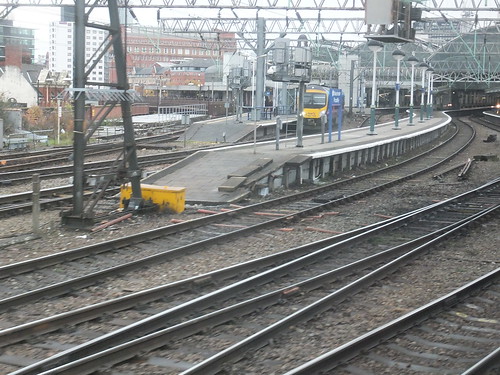 A First TransPennine Express in platform 13 at Manchester Piccadilly in 2013.
A First TransPennine Express in platform 13 at Manchester Piccadilly in 2013.
We picked up a lot more passengers at Stalybridge and then continued on the hilly route into Yorkshire, taking the double track Stalybridge Old Tunnel through Mossley and Greenfield to Diggle. This was an important passenger and freight route for the Lancashire and Yorkshire Railway and from Stalybridge there had been a separate double-track line through Micklehurst, now abandoned, which rejoined the Mossley line at Diggle from where the line continued as four-track to Thornhill. Today, the route is double track although the evidence of the abandoned lines can be seen. Beyond Diggle, we passed through through the 3-mile long double-track Standedge Tunnel. There remain the two abandoned single line tunnels which carried the slow lines before the competition from road transport took away most of the freight traffic. From Manchester, the line climbs continuously to Standedge Tunnel which is level and is the summit of the line. Emerging from the tunnel, it's then downhill right through Huddersfield to Thornhill. There's some information on the route from Stalybridge to Heaton Lodge on the 'Lost Railways West Yorkshire' site here.
Huddersfield Interlude
I alighted at Huddersfield just before 08:45 because I wanted to take some pictures of the remarkable station buildings, which incorporates a range of massive stone buildings with the appearance of a major country seat in Classical style. The famous Doric Arch at Euston station is long gone (in an earlier post on London's Terminal Stations I refer to its demolition as "an act of gross vandalism which will never be forgiven") but Huddersfield retains its magnificent station.
There's a description of the Grade 1 buildings at Huddersfield in "Architect Speak" on the British Listed Buildings Site here. The two-storey central building has six massive columns at the front flanked by colonnades terminated in single-storey lodges on either side.
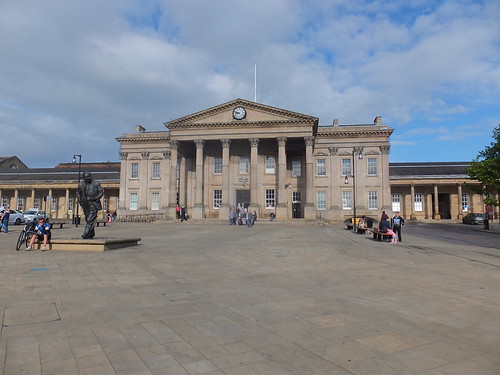 Huddersfield Station.
Huddersfield Station.
The lodge on the left is now the railway-themed 'Head of Steam' public house. The stone pediment carries the carved arms of the Lancashire and Yorkshire Railway, painted in the correct colours.
 The 'Head of Steam'.
The 'Head of Steam'.
The lodge on the right is currently receiving attention from builders. This lodge is also now a public house called the 'King's Head'. The stone pediment carries the carved and coloured arms of the Huddersfield & Manchester Railway & Canal Company, in need of some restoration.
 The arms of the Huddersfield & Manchester Railway & Canal Company above the 'King's Head'.
The arms of the Huddersfield & Manchester Railway & Canal Company above the 'King's Head'.
Just across the adjacent car park there's a somewhat more utilitarian building carrying a water tank, which has been brought into community use by the Association of Community Rail Partnerships (ACoRP). There's a detailed account of the project to convert the Grade 1 listed Huddersfield Water Tower here.
 Huddersfield Water Tower
Huddersfield Water Tower
Huddersfield station also has a large brick goods warehouse incorporating a wagon hoist, apparently disused. There's a collection of pictures here. The building has carried a PDR CONSTRUCTION sign for some years. A very brief entry on their website posted on 12th January 2013 by T. Weber refers rather enigmatically to "£15M Private Investment to Transform Warehouse Into Commercial Units In Huddersfield" so I suppose they're waiting for somebody to offer the finance.
 Huddersfield Goods Warehouse.
Huddersfield Goods Warehouse.
The Journey Resumed
Because of time constraints, I couldn't see much of the town on this trip. I boarded a heavily-loaded Leeds train which lost no time heading for Heaton Lodge Junction where we merged with the Calder Valley Line from Preston and Blackburn. Through Mirfield, there's still a 'third line' designated Up Slow. Mirfield was the site of the unique British Speed Signalling installation described on 'The Signal Box' site here. This was put in by the Chief Signal & Telegraph Engineer of the L.M.S. A. F. Bound in 1932 and lasted until 1970. At Thornhill Junction, we took the Dewsbury line and started climbing again to Morley Tunnel (nearly 2 miles long), emerging on a downhill section which would last the final four miles to Leeds.
We ducked under the electrified line from Doncaster to approach Whitehall Road Junction where there are six running roads. From the north, A and B are the Harrogate lines, C and D are the Doncaster/Shipley lines and E (our line) and F are the Huddersfield lines. Although the six roads normally operate as three sets of double track, they are all bi-directional when required. Control is from York Integrated Electronic Control Centre (IECC). We entered the station on the Through Road and, halfway through the station, took the crossover to stop in platform 12c. The through platforms numbered 7 to 16 (there's also now a bay platform 17) formed Leeds New Station which was shared by the LNWR and the North Eastern Railway.
 Leeds: A fairly daunting Passenger Information Display on platform 12/15.
Leeds: A fairly daunting Passenger Information Display on platform 12/15.
I identified the next Shipley departure and scuttled across the footbridge to reach the terminal platforms numbered 1 to 6 (which originally formed the Midland Railway's separate Leeds Wellington Street Station. Beyond the Midland station was a further terminus, Leeds Central, which was originally joint LNWR, Lancashire & Yorkshire Railway, Great Northern Railway and North Eastern Railway. Once Leeds New Station opened, the importance of Leeds Central declined and it was finally closed in 1967). I'd been directed to a 2-car Class 158 for Carlisle which was about due to leave but the platform was still crowded with waiting passengers and the lady Guard who was unable to open the doors until the Driver climbed into the cab and started the engines. We were pretty full leaving Leeds but I secured as seat and we soon set off on the Down Harrogate, crossing to the Down Shipley at Armley Junction. It didn't take long to cover the 12 miles to Shipley, where the train stopped briefly in platform 2.
 Shipley platform 2, showing the Class 158 setting off for the Settle - Carlisle line.
Shipley platform 2, showing the Class 158 setting off for the Settle - Carlisle line.
Being a station on a triangle of lines, it's easy to be disoriented. I wanted the Station Road exit, so I asked a member of platform staff. He admitted he'd only just moved to Shipley and had no idea. He suggested I check with another member of platform staff who seemed equally foxed. "I think the exit is through a subway" I added, to which the response was a shaking of the head. I lifted my eyes and immediately spotted a sign saying "EXIT - SUBWAY" not ten yards from where we were both standing.
So I was able to walk to the 'Lionsmeet' event and spend a pleasant day with old friends and new friends. One of the club members was concerned at the thought of me walking back to the station and insisted on taking me by car. The next service to Leeds was from Bradford Forster Square (a little under 3 miles away) and I had a few minutes to look around. The original stone station buildings were attractive, later additions in places were not so good and the modern footbridge with lifts was, as usual, out of sympathy with the remainder. The Booking Hall, with its curved glazed screen, was quite appealing, despite the modern fixtures and fittings.
 Shipley Station: the Booking Hall.
Shipley Station: the Booking Hall.
The Return Journey
My train to Leeds arrived at Shipley on time - an almost empty Class 333. It was quiet, comfortable and fast.
 The Class 333 approaching Shipley platform 3 which returned me to Leeds.
The Class 333 approaching Shipley platform 3 which returned me to Leeds.
I finally managed a picture from the train of the two towers adjacent to the station, without the usual "knitting" of the overhead catenary. Only later did I discover they are the Verona Tower of 1864 (actually the boiler house chimney) and the Giotto Tower of 1899 (actually a dust extraction chimney), the remaining parts of the Tower Works of local industrialists the Harding Family. There's an interesting article on the 'Architecture Today' site here. The inspiration for the Leeds Verona Tower is the (much taller) Torre dei Lamberti in Verona, briefly described in Wikipedia here and the British Listed Buildings entry for this Grade II* structure is here. The inspiration for the Giotto Tower is the Giotto Campanile in Florence and is described in Wikipedia here and the British Listed Buildings entry for this Grade II* structure is here.
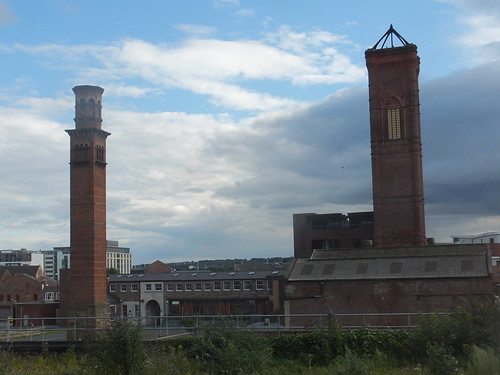 L: The Verona Tower, R: The Giotto Tower.
L: The Verona Tower, R: The Giotto Tower.
Back at Leeds, I made my way to the through platforms for the First TransPennine Express to Manchester Piccadilly. We set off with plenty of spare seats but, by the time we made our last pick-ups at Stalybridge, we were back to people standing. At Piccadilly, I caught the next Arriva Cross Country to the south-west via Wolverhampton.
My pictures
West Midland Railways.
Stoke Area Rail.
Manchester Area Rail.
Huddersfield Station.
Yorkshire's Railways.
Shipley Station.
My trip on Saturday 9th August 2014
In the post Day Trip to Southport and Liverpool (Part 1) I described my train journey to Southport and my brief tour of the town.
The next leg of my journey involved taking a Merseyrail third rail electric service from Southport to Liverpool.
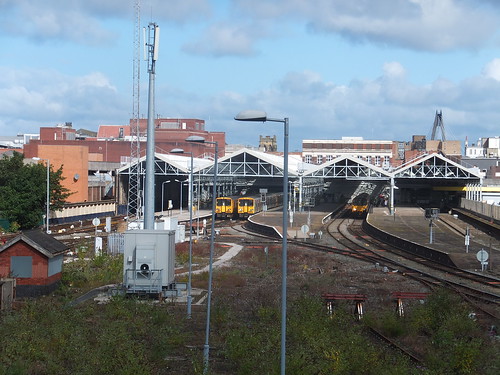 Southport station: The platforms on the left are used by Merseyrail, those on the right by Northern Rail.
Southport station: The platforms on the left are used by Merseyrail, those on the right by Northern Rail.
The building of the line between Southport and Liverpool gained parliamentary approval in 1847 as the Liverpool, Crosby and Southport Railway and opened the following year to temporary stations at both ends. There's a Wikipedia article here which links to articles on all the intermediate stations. In 1855 the railway became part of the Lancashire and Yorkshire Railway and was electrified in 1904. The permanent terminus in Southport was Southport Chapel Street, now simply 'Southport'. In Liverpool the line terminated at Liverpool Exchange. When both this terminus and the terminus at Liverpool Central were closed, British Railways drove a tunnel under the city centre so that electric trains from Southport could join up with the lines serving Liverpool Central (originally operated by the Cheshire Lines Committee - a joint venture by the Great Northern, Great Central and Midland Railways) and that route was electrified as far as Hunts Cross.
You can find out more about Liverpool Exchange at the splendid 'Disused Stations' site here. The impressive station frontage remains, as part of a commercial development.
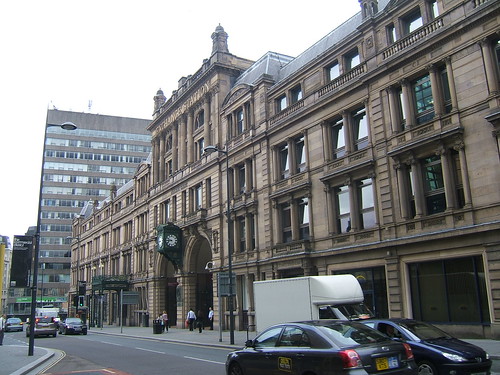 The extensive facade of the former Liverpool Exchange Station.
The extensive facade of the former Liverpool Exchange Station.
The 'Disused Stations' site also has information about Liverpool Central here.
Merseyrail trains on the Northern Line from Southport generally provide a service every 15 minutes stopping at all stations using Class 508 EMU. The whole Merseyrail network is now controlled from the Merseyrail Integrated Electronic Control Centre (IECC) at Sandhills.
It took around forty minutes to reach Moorfields where I left the train and descended to the deep level Wirral Line for the short journey to James Street. In bright sun, from the quay at Canning Dock I admired the preserved lightship 'Planet' which has a new role as a cafe/bar, events venue and museum, as shown on the website here.
 The preserved Lightship 'Planet' in Canning Dock, Liverpool.
The preserved Lightship 'Planet' in Canning Dock, Liverpool.
I couldn't resist continuing to the Museum of Liverpool to check on the exhibit of the 'Lion' locomotive and then taking a journey on the Mersey Ferry to Birkenhead Woodside. This was history repeating itself since I'd made the Museum visit followed by the Mersey Ferry trip on my earlier outing in March 2014 described here.
 'Lion' in the Great Port Gallery.
'Lion' in the Great Port Gallery.
This time, the ferry was the 'Royal Iris of the Mersey'. I remembered the 'Royal Iris' and was puzzled by the 'of the Mersey' suffix. A bit of hunting subsequently showed that the ferry was originally 'Mountwood' (Wikipedia article here). The real 'Royal Iris' (which has a different design) is described here and currently languishes on the Thames as a derelict. An earlier campaign to repatriate her to the Mersey failed but the 'Liverpool Echo' recently reported a new initiative to bring the 'Royal Iris' back here.The 'Royal Iris of the Mersey' was absolutely packed but it was still a great trip.
 'Mountwood' now badged as 'Royal Iris of the Mersey'/
'Mountwood' now badged as 'Royal Iris of the Mersey'/
 'Royal Iris of the Mersey' disembarks a full load at the modernised Pierhead as we wait to board.
'Royal Iris of the Mersey' disembarks a full load at the modernised Pierhead as we wait to board.
Having recently written about Birkenhead (Woodside) station (Services to Birkenhead Woodside in Steam Days), I went to see what remains. I found the station throat, bricked-up approach tunnel, retaining walls and the base of the wall which had supported the arched station roof.
 The overgrown station throat at the former Birkenhead Woodside, viewed from the Church Street overbridge, showing the bricked-up tunnel mouth.
The overgrown station throat at the former Birkenhead Woodside, viewed from the Church Street overbridge, showing the bricked-up tunnel mouth.
In all the times I've travelled from Birkenhead Hamilton Square station, I couldn't remember actually visiting Hamilton Square itself. It's an impressive survivor - a grassed square with a monument to Queen Victoria in the form of an Eleanor Cross in sandstone from Darley Dale in the centre and the Town's Cenotaph near the Town Hall which, flanked by two short terraces of houses forms one side of the square then three blocks of elegant Georgian houses occupy the other three sides of the square. The Town Hall on the east side was built in 1883 and is Grade II*, the south side has a terrace of 17 Grade I houses built in 1839, the north-west terrace has 16 Grade I houses also built in 1839 and the earlier north-east terrace of 18 Grade I houses was built in 1825. All the houses are now in commercial occupation. Nearby, the Sessions Court built in 1885 in "enriched classical style" still serves as the Wirral Magistrates Court. The Wikipedia article here claims that only Trafalgar Square has more Grade 1 Listed Buildings at one location in England.
 Hamilton Square, Birkenhead: The 1825 terrace.
Hamilton Square, Birkenhead: The 1825 terrace.
Amazed by Hamilton Square, I walked back to Hamilton Square station, took the lift down to the Wirral Line and very soon the next train which would take me to Moorfields arrived.
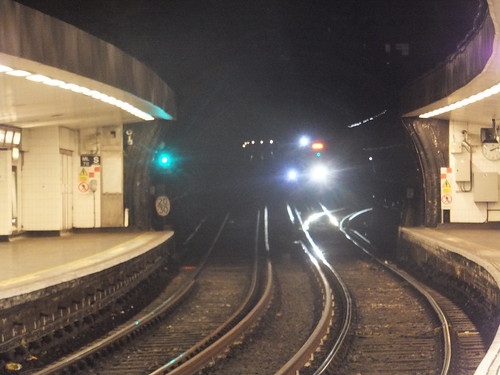 Birkenhead Hamilton Square: Looking towards Hooton from platform 1 showing my train arriving. The line diverging to the right is the Up West Kirby.
Birkenhead Hamilton Square: Looking towards Hooton from platform 1 showing my train arriving. The line diverging to the right is the Up West Kirby.
At Moorfields, I alighted at the single Deep Level platform and used the escalator to the Low Level station, catching the next train heading towards Ormskirk. I decided I had sufficient time to travel as far as Aintree. On leaving Sandhills, we turned right at Sandhills Junction on the Down Ormskirk, leaving the Southport lines on our left. After the Kirkdale Tunnels, we turned left at Walton Junction, leaving the Kirkby lines on our right.
I left the train at Aintree, where the former North Mersey branch appears through a set of gates. It's shown as 'Not In Regular Use' but it gave the appearance of having been abandoned years ago. I walked across the station car park and, just across the road, there was a pedestrian entrance to Aintree Racecourse. A few yards along I found the back of an appalling modern building. It was part of the two new grandstands opened for the 2007 Grand National meeting.
 A study in ugliness: the rear of the new Aintree grandstand.
A study in ugliness: the rear of the new Aintree grandstand.
 This picture from grandnational.org shows the racecourse side of the new grandstands. No improvement on the rear, in my opinion.
This picture from grandnational.org shows the racecourse side of the new grandstands. No improvement on the rear, in my opinion.
The Grand National Website says of the new grandstands "The Earl of Derby and Lord Sefton grandstands were designed to offer first-class viewing facilities for the 21st century spectator, and both stands fit the brief perfectly" but I couldn't get over the ugliness and hurried back to the station to catch the first train back towards the city. This time, I left the train at Kirkdale where Merseyrail have a major depot.
 Kirkdale, showing the Merseyrail Depot.
Kirkdale, showing the Merseyrail Depot.
I left the station and walked north along Hawthorne Road. Side streets revealed long terraces of houses much more basic than Hamilton Square. Traditional shops were offering cheaper products. This is more the Liverpool I remember from past visits - a world away from the expensive apartments which proliferate nearer the City Centre. I made my way back to the station, tiring from the heat. I caught the next train to Kirkby.
 My Kirkby Train arrives at Kirkdale.
My Kirkby Train arrives at Kirkdale.
The Merseyrail network now is mainly double track but in the days of the Lancashire and Yorkshire Railway and its successor the L.M.S. many of the lines were 4-track in order to cope with both passenger and freight traffic. Leaving Liverpool Exchange and through Exchange Junction there were four lines (Down Fast, Up Fast, Down Slow, Up Slow). Beyond Sandhills No. 1, there were four lines towards Southport (Up East, Down East, Up West, Down West) and four towards Kirkdale (Down Fast, Up Fast, Down Slow, Up Slow). Kirkdale had extensive marshalling sidings which provided the land for the modern Merseyrail depot and the four tracks once continued to Walton Junction. Only two are needed for Merseyrail trains but the abandoned Kirkdale Tunnels are still visible. Continuing to Kirkby there is little hint that, around Fazakerley and Aintree, there were marshalling sidings rivalling those at Edge Hill, Liverpool (described here). I'll return to the Fazakerley/Aintree area when I can. About a mile short of Kirkby, the Up and Down lines merged into a single line. The Merseyrail train entered the platform at Kirkby and stopped. Of course, the Lancashire and Yorkshire line was double track through to Wigan Wallgate but there is now a physical break at Kirkby. Passengers alighting from the Merseyrail train wishing to travel onwards must walk down the platform to where, hopefully, the Northern Rail connecting service is waiting. Not so much fun if it's raining!
 Passengers walking from the Merseyrail train under the roadbridge to join the Northern Rail service.
Passengers walking from the Merseyrail train under the roadbridge to join the Northern Rail service.
 The Class 150 ready to take passengers from Kirkby.
The Class 150 ready to take passengers from Kirkby.
The Class 150 set off, travelling about five miles on single track and passing a single connection (controlled from a Ground Switch Panel) to Knowsley Freight Terminal operated by Potter Logistics. At Rainford Junction, double track resumed. The turnout and facing point lock was mechanically operated from the signal box and semaphore signals were in use. The L&Y style signal box once controlled a 3-way junction and had a 56-lever tappet frame. Behind the signal box, you can just make out the start of what was an LNWR branch to St. Helens. On the other side, I couldn't spot any sign of the Lancashire and Yorkshire Railway branch to Ormskirk.
 Rainford Junction Signal Box showing point rodding, semaphore bracket signal and (between the rails level with the signal) the TPWS 'Stop' loops.
Rainford Junction Signal Box showing point rodding, semaphore bracket signal and (between the rails level with the signal) the TPWS 'Stop' loops.
Another six miles and we were back at Wigan Wallgate. Tired but pleased with what I'd seen I walked back to Wigan North Western station and caught the first available service home.
Pre-grouping railways in West Lancashire
 Click for larger view.
Click for larger view.
My journey from Southport to Liverpool was on the former Lancashire and Yorkshire line (blue/white) to Moorfields where I changed Merseyrail's Wirral Line (originally the Mersey Railway) for the short trip to James Street. I then crossed the Mersey by ferry, returning from Hamilton Square to Moorfields. Here I took the former Lancashire and Yorkshire Railway to as far as Aintree on the line to Ormskirk, before returning to Kirkdale and taking the line to Kirkby where I changed to go forward to Wigan. Many of the railways on this map no longer exist.
 Railway Clearing House Map of Liverpool Railways.
Railway Clearing House Map of Liverpool Railways.
Click for other sizes or to download.
My pictures
General pictures:
Liverpool.
Museum of Liverpool.
Birkenhead and its Docks.
Railway pictures:
Southport's Railways.
Merseyrail.
Lancashire & Yorkshire Railway in West Lancs.

 The concourse at Liverpool Street station.
The concourse at Liverpool Street station.
 WWI War Memorial, complete with lift doors.
WWI War Memorial, complete with lift doors.
 Click here for larger image
Click here for larger image Click here for larger image
Click here for larger image A 'national express' Class 313 service leaving Liverpool Street on the Down Suburban in 2011.
A 'national express' Class 313 service leaving Liverpool Street on the Down Suburban in 2011.
 The Class 321 for Southend stands in Liverpool Street.
The Class 321 for Southend stands in Liverpool Street.
 The Olympic Park under construction in 2011. L: Olympic Stadium R: ArcelorMittal Tower.
The Olympic Park under construction in 2011. L: Olympic Stadium R: ArcelorMittal Tower.
 The same location in 2014. L: West Ham stadium under conversion R: ArcelorMittal Orbit.
The same location in 2014. L: West Ham stadium under conversion R: ArcelorMittal Orbit.
 View of Stratford Station from platform 9. L to R: Westfield Stratford City, Overground platforms, Down & Up Temple Mills platforms, Southend lines.
View of Stratford Station from platform 9. L to R: Westfield Stratford City, Overground platforms, Down & Up Temple Mills platforms, Southend lines.
 Trackwork at the east end of Stratford International.
Trackwork at the east end of Stratford International.








































